Rikyū Konomi: Favored Tea Utensils
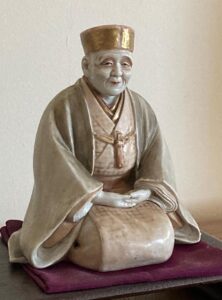
Sen no Rikyū was and remains the leading influence of Chanoyu and Japanese culture. Many of the utensils used in Chanoyu were and are the konomi, or choice, of Sen no Ri-kyū, 千利休, Thousand Rich-quit. Konomi or konomu, 好, means fond, pleasing, like something, wish, desire, choice, preference, etc. Many of the utensils were created bearing the choice or taste of Rikyū. For example, he worked together with a Korean potter, Chō-ji-rō, 長次郎, Lengthy-next-son, in the creation of ceramic wares that became known as Raku-yaki, 楽焼, Pleasure-fired. Artists and craft persons were inspired by these works and copied them, establishing various traditions. Rikyū had many associates and followers. His grandson, Sō-tan, 宗旦, Sect-dawn, was the ancestor of several branches of the Sen family that followed his ways and concepts.
Some of Rikyū’s choices are essential utensils used to this day in the creation of lavish, costly, formal, aristocratic Tea presentations to the simplest manner in which to make Tea. Many of the utensils are related through purpose and size. Rikyū’s name throughout most of his life was Sō-eki, 宗易, Sect-change, which is borrowed from the classic means of Chinese divination called the I Ching, 易経, Change-sutra, in Japanese known as the Eki-kyō. This system is based on negative and positive aspects of every thing, called the On-myō, 陰陽, In Yō, Yin and Yang, negative positive, water and fire, etc. These dual aspects are combined with the Go-gyō, 五行, Five-transitions, five physical elements, and the Go-rin, 五輪, Five principles. These are collectively associated with the Asian zodiac, the Jū-ni-shi, 十二支, Ten-two-branches, twelve animal signs.
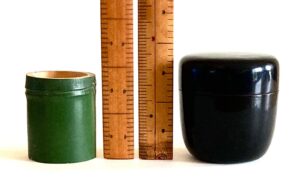
Intrinsic to the wabi taste of Chanoyu are the ao-dake futa-oki, 青竹蓋置, green-bamboo lid-place, moto-bushi, 元節, origin-node; H. 1.8 sun kane-jaku, and the chū-natsume, 中棗, middle-jujube, mirror-finished black lacquered, ovoid tea container; H. 1.8 sun kujira-jaku.
Rikyū established the standard height of the futa-oki at 1.8 sun kane-jaku, especially the ao-dake, 青竹, green-bamboo, hiki-kiri, 引切, draw-cut. Rikyū’s teacher, Take-no Jō-ō, 武野紹鴎, War-field Help-gull, had a bamboo futaoki that he used in the mizu-ya, 水屋, water-house, preparation room, and it measured 1.3 sun kane-jaku. Rikyū increased the height to 1.8 sun kane-jaku, perhaps because the number 18 had a deeper symbolic meaning for him.
The number 18 can be written 1.8 sun, and i-ssun hachi-bu, 一寸八分.
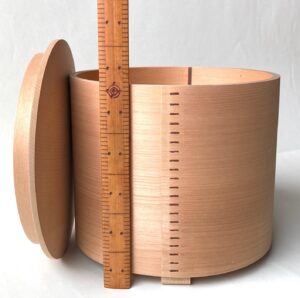
Mage mizu-sashi, 曲水指, bend water-indicate, cedar with 21 sakura kaba, 桜樺, cherry birch, bark stitches sealing the overlapping seam. The seam establishes the shō-men, 松柏, true-face. The vessel has three wooden feet with one foot that also establishes the shōmen. The seam of the lid is upright, which is its location at the back of the vessel when closed.
The 21 visible cherry bark stitches may reference the 21 spontaneously inherent qualities of the Buddha’s Dharmakaya, known in Japanese as the Hō-shin, 法身, Law-body. In some Buddhist sects, there are specific practices that address the twenty one active Dharmakaya qualities as they appear in the 21 emanations of Tara, a deity with close associations to Kannon.
The full height of the mage mizu-sashi, 曲水指, is 5.5 sun kane-jaku. Without the lid, the height of the mizusashi is 5.1 sun kane-jaku. Subtracting the height of the three supporting wooden feet, the height of the mizusashi is 4.8 sun kane-jaku. The diameter of the lid is 6 sun kane-jaku, which is equal to 4.8 sun kujira-jaku. The relationship between the measurements of the mizusashi and the lid relate to each other 8 to 10. The ratio is 8 to 10: hi-ritsu wa hachi tai jū desu, 比率は八対十です, equal-ratio as-for eight equal ten is. The ratio of 8:10 reduces to 4:5, and 4 plus 5 is 9. The ratio of one object measured with kane-jaku (mizusashi) relative to the other object measured with kujira-jaku (the lid), manifests the number 9 regardless of the objects’ actual sizes. A mizusashi displayed in the Tearoom is 9/10ths, ku-bu, 九分, full of water whereas a mizusashi carried into the room in the presence of the guests is 8/10ths, hachi-bu, 八分, full of water.
An object of two parts that can be compared or that can be divided into nine-divisions or parts: ku-bun, or traditionally read, ku-bu, 九分. Ku-bu maybe intentional wordplay on kubu, as with the Buddhist Ku-bu-kyō, 九部経, Nine-section-sutra. The kubukyō is often described as a way to categorize various teachings and does not necessarily refer to one particular sutra.
As it happens, the Heart Sutra divides the human experience of existence into nine aspects. The nine parts of the ‘sutra’ are divided as well into a group of five, related to the five senses, and four others identified with levels of consciousness. These may equate with the four and five parts of an object.
Ku-shiki, 九識, Nine-consciousnesses, are essential Buddhist concepts:
Gen-shiki, 眼識, Eye-consciousness.
Ni-shiki, 耳識, Ear-consciousness.
Bi-shiki, 鼻識, Nose-consciousness.
Zetsu-shiki, 舌識, Tongue-consciousness.
Shin-shiki, 身識, Body-consciousness.
I-shiki, 意識, Mind-consciousness.
Ma-na-shiki, 末那識, End-what-consciousness; perception of self.
A-ra-ya no Hachi-shiki, 阿頼耶 の八識, Flatter-trust-what’s Eight-consciousnesses; consciousness forming the base of all human existence.
An-ma-ra no shiki, 菴摩羅の識, Hermitage-polish-spread’ consciousness.
There is a further teaching regarding consciousness within the sutra that is given by Kannon to Sha-ri-hotsu, 舎利弗, House-advantage-not, in the form of mantra, Shin-gon, 真言, True-word.This mantra expresses what could be considered, Mu-ku no shiki, 無垢の識, No-dirt’s consciousness; pure consciousness.
Nine in Buddhism can be found in Ku-shiki, 九識, Nine-consciousnesses. ‘Shiki’ as in ‘fu-shiki’, 不識, no-consciousness, which was Daruma’s answer to the Chinese emperor’s question, ‘who are you?’
The Heart Sutra, Han-nya Shin-gyō, 般若心経, Carry-young-heart-sutra, is essential in the development and understanding of Buddhism, especially in Japan. There are other very important sutras and texts that are also used.
The Heart Sutra has 28 verses, with additional verses. A pack of kai-shi, 懐紙, heart-paper, is comprised of 30 sheets of paper that are folded. The kaishi preferred in the Tearoom and both sizes for women and men was determined by Sen no Rikyū. There is another parallel between the Heart Sutra and the kaishi, and that is the reference to the ‘heart’. Shin of shin-gyō, is shin, kokoro, 心, heart — kai of kai-shi, 懐, refers to the area of the kimono near the heart.
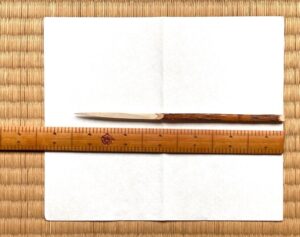
An open sheet of men’s kai-shi, 懐紙, heart-paper; L. 6.8 sun kane-jaku, kuro-mo-ji, 黒文字, black-character-letter; L. 6 sun kane-jaku.
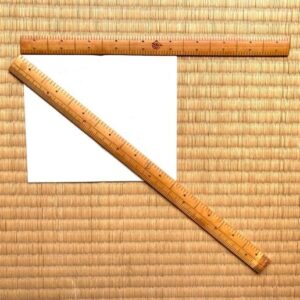
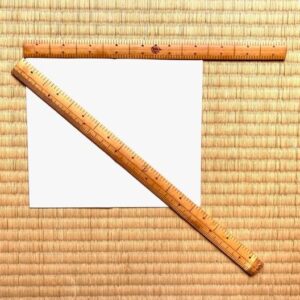
The kaishi for men has a diagonal of 8.93 sun kane-jaku, which is very nearly 9 sun kane-jaku. If the diagonal were 9 sun kujira-jaku, the diagonal would be 7.2 sun kujira-jaku.
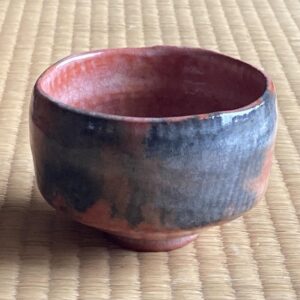
Cha-wan, 茶碗, tea-bowl, aka-raku, 赤楽, red-pleasure, with red glaze and black glaze area by Sa-sa-ki Shō-raku, 佐々木昭楽, Assist-help-tree; diam. 4 sun kane-jaku. The bowl is inspired by the chawan named ‘Ki-mamori’, 木守, Tree-protect, made by Chō-ji-rō, 長次郎, Long-second-son.
Ki-mamori, 木守, tree-protector, refers to a persimmon that is left on a tree for a bird to take away and scatter its seeds elsewhere, aiding in proliferating the trees. The Kanji for persimmon, 柿, is composed of moku, 木, tree, and shi, 市, city, signifying that it is a planted tree, rather than growing naturally. Rikyū went with his followers to Chōjirō’s for everyone to choose a chawan. After they made their selections, one chawan remained, which Rikyū chose, and called it ‘Ki-mamori’. The chawan was so-named because it was not chosen by any of Rikyū’s followers when they each selected chawan made by Chōjirō.
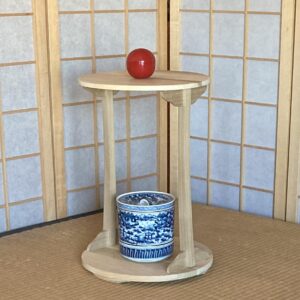
Tana, 棚, shelf, Rikyū maru-joku, 丸卓, round-stand, display stand composed of round baseboard raised on three feet, and round upper shelf supported on two curved posts, made of poplar wood, by Joseph Van Benten, Chestnut Hill, Massachusetts. Mr. Van Benten was asked to make a copy of Rikyū’s maru-joku, and after he finished the piece, said it was one of the most challenging works of cabinetry he had ever attempted. It was impossible to find wood large enough to provide a complete circle, and therefore he had to piece the shelves together. There are no Kanji for poplar wood, so it is written in Kana, ポプラ, po-pu-ra.
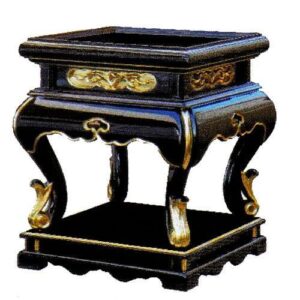
The display stand is a variation of a Buddhist kō-joku, 香卓, incense-stand, which is used to support a kō-ro, 香炉, incense-hearth, on the top shelf. The placement of an incense burner on the top shelf, may be identified with the cha-ki, 茶器, tea-container, on the upper shelf of a tana, comparing incense to tea. Both tea and incense are offerings that are shared with those making the offerings.
When the maru-joku, 丸卓, round-stand, is used with the fu-ro, 風炉, wind-hearth, which has one foot as shō-men, 正面, correct-face, two feet of the tana are shōmen; when used with the ro, the tana is placed with one foot as shōmen.
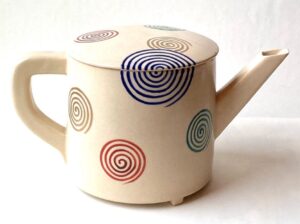
Mizu-tsugi, 水次, water-next, ceramic kata-kuchi, 片口, side-mouth, with C-handle, and self-lid, decorated with various color glaze uzu-maki, 渦巻き, spiral-wrap; un-signed. The pictured pitcher is based on a Chinese model constructed of bent wood, mage-mono, 曲物, similar to the above mizusashi. Following a certain precept, both the mizu-tsugi and the mage mizu-tsugi have three feet, and one foot is shōmen. The mizu-tsugi were it to be made of bentwood, the one foot as shōmen is located near the C-handle.
When replenishing the water in the mizusashi on the maru-joku, which has two posts, the mizusashi usually remains in place on the ji-ita, 地板, earth-board. This requires the use of a mizu-tsugi, 水次, water-next, a pitcher with a handle and spout on its side, called a kata-kuchi, 片口, side-mouth. The distance between the jiita and the upper shelf, ten-ita, heaven-board, is such that it would not allow space for a mizu-tsugi with a bale handle, such as Rikyū’s koshi-guro ya-kan, 腰黒薬鑵, bottom-black medicine-boiler.
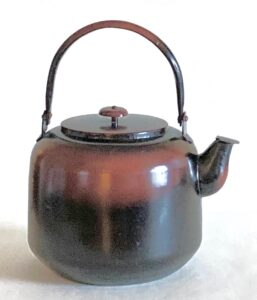

Koshi-guro ya-kan, 腰黒薬鑵, bottom-black medicine-boiler, patinated copper, with lidded spout, and bail handle. Heating liquid in a metal pitcher over an open fire.
Rikyū’s yakan was theoretically placed directly into a fire, which caused blackening on the surface. However, the koshiguro was and is actually placed in a fire to make herbal infusions. Like most interpretations of Rikyū’s yakan, the pictured pitcher was intentionally patinated black to give the impression that it once contained herbal medicinal ‘tea’.
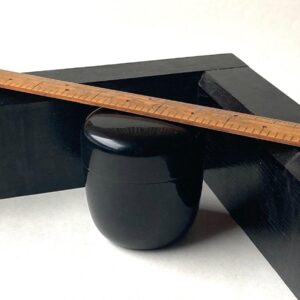
Rikyū-gata chū-natsume, 利休形中棗, Rikyū-form middle-jujube, black-lacquered wood, ovoid tea container; h. 1.8 sun kujira-jaku, placed next to a corner of the ro-buchi, 炉縁, hearth-frame, black-lacquered wood; h. 1.8 sun kujira-jaku. The kujira-jaku ruler made of bamboo, including centimeter measurements shows the equal heights.
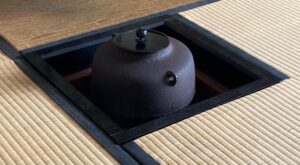
Rikyū determined the width of the ro opening in the Tearoom to be 14 sun kane-jaku. The ro was created to use the earlier large ‘temple’ size kama, 釜, kettle. The portable fu-ro, 風炉, wind-hearth, and kama were large, too large for rooms that had tatami. The large furo was abandoned, or used in the 10th, month for naka-oki, 中, middle-place. The large, valued kama was used in the i-ro-ri, 囲炉裏, enclosed-hearth-inner, which was an essential element in the home. The word irori contains the word ro, which was used to specify the hearth for Chanoyu. Before Rikyū, people built a ro that could accommodate the size of their own kama. It was Rikyū who established the standard size of the ro opening in the floor.
The size of the opening in the ro-dan, 炉壇, hearth-foundation, was also determined by Rikyū. The size of the opening is one shaku kane-jaku or hassun kujira-jaku. The height of the ro-buchi, 炉縁, hearth-frame, which protects the surrounding tatami, had to include the thickness of the tatami as well as the actual floor boards. It may have been Rikyū who determined that the height of the robuchi was 1.8 sun kujira-jaku, which is the same height of his chu-natsume, 中棗, middle-jujube, tea container.
Rikyu established many objects, like the size of the ro opening of 14 sun kane-jaku. He also established the size of the fuku-sa, 帛紗, cloth-gauze, at 9 x 9.5 sun kane-jaku. Sō-on, 宗恩, Sect-grace, Rikyu’s wife is credited with changing the kind of fabric for the fukusa from the lavish, gold embroidered silk treasures to plain silk shio-ze, 塩瀬, salt-shoal. There are several fabrics that are associated with Rikyū, and are used to make ko-buku-sa, 古帛紗, old-cloth-gauze, shi-fuku, 仕覆, serve-cover, etc.
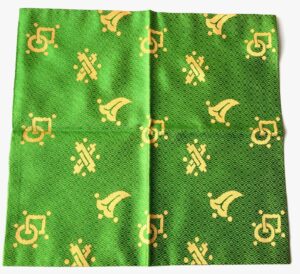
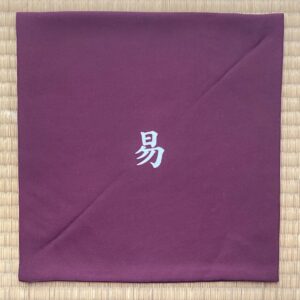
Dashi buku-sa, 出帛紗, out cloth-gauze, gold and green silk with pattern of takara-zukushi, 宝塚, treasure-trove, by Tatsu-mura, 龍村, Dragon-town, Kyōto. Memento of Zabōsai’s, 坐忘斎, Sit-forget-abstain, becoming Waka-sō-shō, 若宗匠, Young-sect-artizan, in 1988, at Hei-an Jin-gu, 平安神宮, Level-peace God-palace, Kyōto. Fuku-sa, 帛紗, cloth-gauze, purple silk with a image of the Kanji eki, 易, change, in honor of Rikyu’s name Sō-eki, 宗易, Sect-change. Kyō Noren, Kyōto.
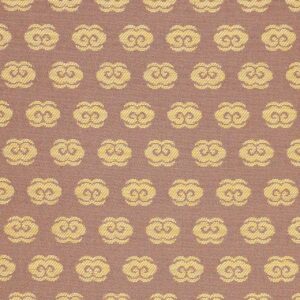
Rei-shi-kumo, 霊芝雲, Soul-turf-cloud, is a fabric pattern of stylized clouds in gold brocade on an orange ground. The fabric pattern is said to have been like the ke-sa, 袈裟, camlet-Buddhist surplice, Buddhist garment that is sort of a shawl and apron, worn over the shoulder, by Dai-tō Koku-shi, 大燈国師, Great-lamp Country-master, [1282-1338]. He was the founder of Dai-toku-ji, 大徳寺, Great-virtue-temple, of the Rinzai sect, in Kyōto. This fabric was favored by Sen no Rikyu who practiced Zen at Daitokuji Temple. The motif became prized among tea masters and was called Dai-toku-ji Kin-ran, 大徳寺金襴, Great-virtue-temple gold brocade.
Clouds with claws placed on the top and bottom are called reishi clouds, and were prized as a pattern symbolizing eternal fertility due to the reishi mushrooms, which symbolize eternal youth and longevity, and the clouds that bring forth crops.
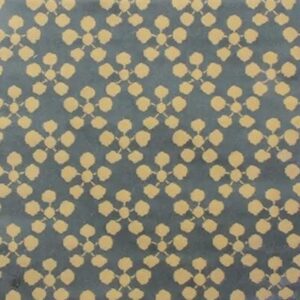

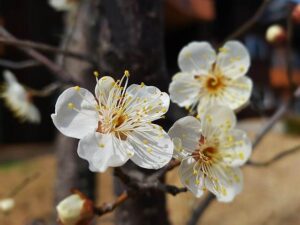
The pictured flower with green leaves is called Rikyū-bai, Exochorda racemosa, Common pearlbush. The pictured flower with the dark background is the familiar ume no hana, 梅の花, prunus’s flower, Prunus mume.
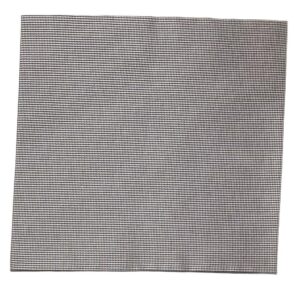
Ko-buku-sa, 古帛紗, old-cloth-gauze, silk square named ‘Rikyū Kan-tō’, 利休間道, Rikyū Interval-way, by Toku-sai, 徳斎, Virtue-abstain. The kanji, 帛, is the old character for silk as well as cloth. The ‘gray’ color is called Rikyū ‘nezumi’, 鼠, rat, because the rat is gray.
For further study, see also: Rikyū’s Memorial, Rikyū Chū Natsume, Hōunsai Konomi, and Natsume Chasen Chashaku

